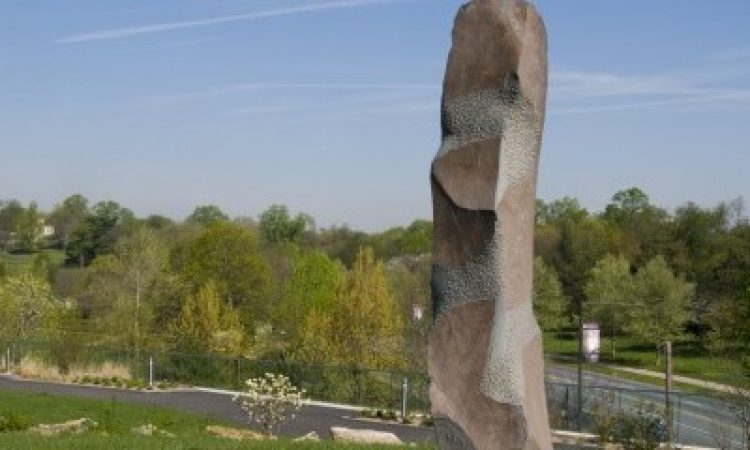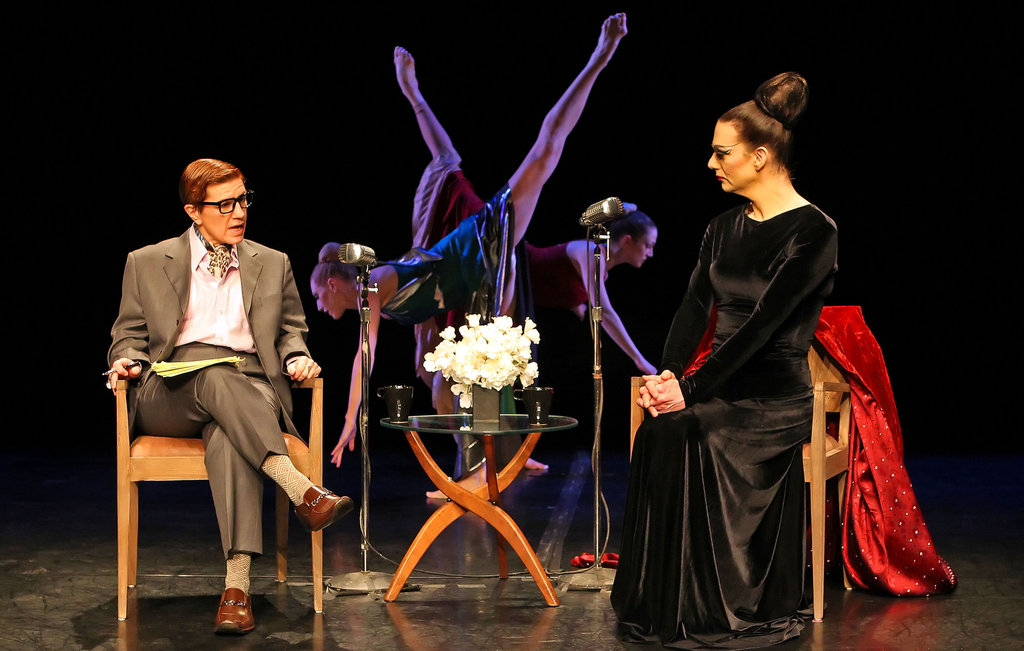Four large sculptures by the renowned sculptor and frequent dance set designer, Isamu Noguchi (1904–88), have been installed at the Philadelphia Museum of Art’s Anne D’Harnoncourt Sculpture Garden overlooking the Schuylkill River. They are on loan from the Noguchi Museum in Long Island City, New York. I visited the garden with pen and camera in hand, curious to discover any connections with Noguchi’s stage design for dance.
Noguchi’s long connection with modern dance started in 1925 with his mask-like bronze of Michio Ito (1892–1961), a Japanese dancer who encouraged Noguchi’s interest in the arts. He followed with portrait heads of dancers Michel Fokine (1926), Doris Humphrey, Lincoln Kirstein, and Martha Graham (all from 1929), as well as Sono Osato(1940). Noguchi’s sister, Ailes Gilmour (1912–93), became an early member of Martha Graham’s company and stated that she introduced her brother to Graham, sparking a decades-long artistic collaboration.
The sculptor’s 1935 set for Graham’s austerely beautiful solo, Frontier, initiated a steady stream of stunning designs for some of her most renowned creations, until the 1967 production, Cortege of Eagles. In 1976 Noguchi designed an entire theater for Graham, a project that was, unfortunately, never realized. He also collaborated on sets and costumes with other dance artists including Erick Hawkins (John Brown, 1945, and Stephen Acrobat, 1947), Merce Cunningham (The Seasons, 1947), and George Balanchine (Orpheus, 1948). But Noguchi’s interest in the moving body was evident even before he met Graham, as revealed in such early works as Man Kneeling (1928; Noguchi Museum) and Expanding Universe (versions in plaster and wool jersey, 1932; Noguchi Museum). The latter sculpture in wool fabric, looks strikingly like Graham herself, falling with angular resistance to the floor, in her “long woolens” period (late 1920s to mid 1930s), although it was actually a costume design for a ballet by Ruth Page.
At Graham company performances I have attended, I marveled at Noguchi’s constructions as much as I did at the choreography, particularly the agonizingly angled design for Night Journey (1947), the expansive and shimmering set for Seraphic Dialogue (1955), and the funny off-center barre in Acrobats of God (1960). Long-time Graham soloist Janet Eilber has written about the demands of Noguchi’s designs on dancers: “all the ingenious techniques Isamu used to create the incredibly effective illusions—the raked angles, the organic curves and exaggerated corners—are exactly what provide the greatest challenge for those of us who must enhance and extend those illusions.” (http://marthagraham.org/wp-content/uploads/2012/02/Martha-Graham-Dancer-Speaks-Out.pdf). Watching each dance unfold, I sensed those struggles and the mastery they demanded.
The four works at the D’Harnoncourt Sculpture Garden largely post-date Noguchi’s dance collaborations. Still, moving along the paths leading from one work to another, I could picture Graham, perched on—or, with her dancers—moving through these pieces. Origin (1968), the oldest work displayed, is a granite mound that emerges smoothly and with varied surfaces from its grass footing. It looked to me like Darth Vader’s helmet set on the hill, but it far predated the film that featured this now iconic image. The sculpture combines the softness of its rounded form with the hardness of its dark, solid material. Origin could be a turtle, a head, a breast, or a hillock of the unconscious mind around which to curl one’s body. Like the Star Wars headgear, it conjures archetypal connections that engage the viewer’s mind and gut.
Similarly, Untitled (1986), also of granite, made me think of Graham poised on some multi-dimensional seat, perhaps in Seraphic Dialogue (1955) or Clytemnestra (1958), hardly comfortable yet watching in lively retrospection as the dramatic action of her character’s life unfolds before and within her. Untitled is both rounded and angular, a cave and a passageway—just the kind of rich contradictions that Graham so effectively brought out in her own modern-yet-ancient characters.
Rain Mountain (1982–83) is the only steel structure among the PMA’s Noguchi loans. Tall and thin, the four dripping figures that emerge from—or melt into—the ground are intersected about two-thirds of the way up by a rectangle that sharply contrasts with their curving projections. The severe juxtapositions reminded me of Noguchi’s designs for Judith (1950), with its geometrically printed screens stretched in a line across the stage, and Clytemnestra, where a series of metallic forms vertically pierce the dance space.
Finally, I pondered Dance (1982), a stone sculpture that is, for me, the centerpiece of this Noguchi quartet. Created well after the height of Noguchi’s dance collaborations, the sculptor crafted in this nearly seven-foot high totemic work, a variously textured column that spirals and shifts as it carries the eye from base to tip. He subtly altered the colors from red-brown to gray, and the surfaces from smooth to stippled, concave to gently bulging. Noguchi’s Dance, like his theater designs, makes concrete “those projections of the imagination into environmental space which are denied us in actuality” (Martha Graham and Isamu Noguchi: A Brilliant Collaboration: http://www.carnegiehall.org/BlogPost.aspx?id=4294974067). Inside that stone a dance is emerging, pounding and reverberating, breathing in and out. Contract, release; spiral, center; ground and rebound.
Sculpture by Isamu Noguchi is on view through the summer of 2013 in the Anne D’Harnoncourt Sculpture Garden of the Philadelphia Museum of Art . Both photographs displayed with this article are published by courtesy of The Isamu Noguchi Foundation and Garden Museum and the Philadelphia Museum of Art.






